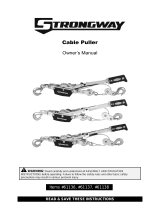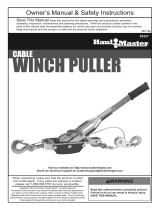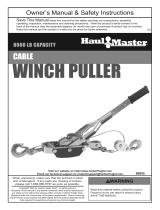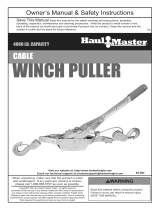Page is loading ...

Operating Instructions and Parts Manual
JCP Series Cable Pullers
JET
427 New Sanford Road
LaVergne, Tennessee 37086 Part No. M-180410
Ph.: 800-274-6848 Revision B1 06/2014
www.jettools.com Copyright © 2014 JET

2
Warranty and Service
JET warrants every product it sells against manufacturers’ defects. If one of our tools needs service or repair,
please contact Technical Service by calling 1-800-274-6846, 8AM to 5PM CST, Monday through Friday.
Warranty Period
The general warranty lasts for the time period specified in the literature included with your product or on the official
JET branded website.
• JET products carry a limited warranty which varies in duration based upon the product. (See chart below)
• Accessories carry a limited warranty of one year from the date of receipt.
• Consumable items are defined as expendable parts or accessories expected to become inoperable within a
reasonable amount of use and are covered by a 90 day limited warranty against manufacturer’s defects.
Who is Covered
This warranty covers only the initial purchaser of the product from the date of delivery.
What is Covered
This warranty covers any defects in workmanship or materials subject to the limitations stated below. This warranty
does not cover failures due directly or indirectly to misuse, abuse, negligence or accidents, normal wear-and-tear,
improper repair, alterations or lack of maintenance.
Warranty Limitations
Woodworking products with a Five Year Warranty that are used for commercial or industrial purposes default to a
Two Year Warranty. Please contact Technical Service at 1-800-274-6846 for further clarification.
How to Get Technical Support
Please contact Technical Service by calling 1-800-274-6846. Please note that you will be asked to provide proof
of initial purchase when calling. If a product requires further inspection, the Technical Service representative will
explain and assist with any additional action needed. JET has Authorized Service Centers located throughout the
United States. For the name of an Authorized Service Center in your area call 1-800-274-6846 or use the Service
Center Locator on the JET website.
More Information
JET is constantly adding new products. For complete, up-to-date product information, check with your local
distributor or visit the JET website.
How State Law Applies
This warranty gives you specific legal rights, subject to applicable state law.
Limitations on This Warranty
JET LIMITS ALL IMPLIED WARRANTIES TO THE PERIOD OF THE LIMITED WARRANTY FOR EACH
PRODUCT. EXCEPT AS STATED HEREIN, ANY IMPLIED WARRANTIES OF MERCHANTABILITY AND FITNESS
FOR A PARTICULAR PURPOSE ARE EXCLUDED. SOME STATES DO NOT ALLOW LIMITATIONS ON HOW
LONG AN IMPLIED WARRANTY LASTS, SO THE ABOVE LIMITATION MAY NOT APPLY TO YOU.
JET SHALL IN NO EVENT BE LIABLE FOR DEATH, INJURIES TO PERSONS OR PROPERTY, OR FOR
INCIDENTAL, CONTINGENT, SPECIAL, OR CONSEQUENTIAL DAMAGES ARISING FROM THE USE OF OUR
PRODUCTS. SOME STATES DO NOT ALLOW THE EXCLUSION OR LIMITATION OF INCIDENTAL OR
CONSEQUENTIAL DAMAGES, SO THE ABOVE LIMITATION OR EXCLUSION MAY NOT APPLY TO YOU.
JET sells through distributors only. The specifications listed in JET printed materials and on official JET website are
given as general information and are not binding. JET reserves the right to effect at any time, without prior notice,
those alterations to parts, fittings, and accessory equipment which they may deem necessary for any reason
whatsoever. JET
®
branded products are not sold in Canada by JPW Industries, Inc.
Product Listing with Warranty Period
90 Days – Parts; Consumable items; Light-Duty Air Tools
1 Year – Motors; Machine Accessories; Heavy-Duty Air Tools; Pro-Duty Air Tools
2 Year – Metalworking Machinery; Electric Hoists, Electric Hoist Accessories; Woodworking Machinery
used for industrial or commercial purposes
5 Year – Woodworking Machinery
Limited Lifetime – JET Parallel clamps; VOLT Series Electric Hoists; Manual Hoists; Manual Hoist
Accessories; Shop Tools; Warehouse & Dock products; Hand Tools
NOTE: JET is a division of JPW Industries, Inc. References in this document to JET also apply to JPW Industries,
Inc., or any of its successors in interest to the JET brand.

3
3.0 Safety warnings
1. Read and understand owner’s manual before operating cable puller.
2. Do not exceed rated capacity.
3. Supporting structure used with this device must provide adequate support to handle all puller
operations plus the weight of the puller and attached equipment. If in doubt, consult a registered
structural engineer.
4. Never use handle extensions (cheaters).
5. Do not use with twisted, kinked or damaged wire rope.
6. Do not use if cable puller is damaged or malfunctioning.
7. Do not lift people or loads over people. Always keep people clear from load path.
8. Always keep a minimum of (3) wraps of wire rope on drum.
9. Do not use with open or twisted hook, or without safety latch.
10. Never run wire rope over a sharp edge.
11. Never leave a suspended load unattended.
12. Do not swing a suspended load.
13. Always inspect cable puller before each use. Replace if any component is damaged or malfunctioning.
14. Always use gloves when handling wire rope. Do not wear loose clothing which can become entangled
in moving parts.
15. Failure to comply with the above warnings may result in personal injury and/or property damage.
Specifications: JCP Series Cable Pullers
Model .......................................................................JCP-1 .............................JCP-2 ...................... JCP-4
Stock Number ........................................................ 180410 ........................... 180420 .....................180440
Weight Capacity (ton) ...................................................... 1 .................................... 2 ............................. 4
Maximum Lift (ft) ........................................................... 12 .................................... 5 .............................. 5
Lever Ratio................................................................. 18:1 ............................... 36:1 ......................... 36:1
Lever Length (in) ..................................................... 16-1/2 ............................ 16-1/2 ...................... 17-1/8
Minimum Distance Between Hooks (in) ......................... 17 .................................. 21 ............................ 22
Wire Rope Diameter (in)............................................. 3/16 .............................. 3/16 ........................... 1/4
Net Weight (lbs) .............................................................. 7 .................................... 9 ............................ 13
The JET JCP-Series Cable Pullers comply with ANSI/ASME B30.21 standards.
The specifications in this manual are given as general information and are not binding. JET reserves the
right to effect, at any time and without prior notice, alterations to parts, fittings, and necessary equipment
deemed necessary for any reason whatsoever.

4
JCP Series Cable Pullers
Fig. 1
A – Handle
B – Forward/Reverse Latch
C – Spring
D – Pawl
E – Wire Rope
F – Locking Lever Plunger
G – Locking Lever Spring
H – Ratchet Wheel
J – Locking Lever
K – Bottom Hook
L – Snatch Block (models JCP-2, JCP-4 only)
M – Wire Rope Guide Bolt
N – Top Hook
O – Wire Rope Guide
Operation
Hook Positioning with No Load (Freewheel)
(Fig. 1)
1. With no load on cable puller, position
forward/reverse latch (B) as shown on
dotted lines, to hold pawl (D) off ratchet
wheel (H).
2. Hold puller firmly with handle in uppermost
position, and press locking lever (J) to
disengage locking lever from ratchet wheel.
3. Have an assistant, also wearing gloves, pull
wire rope out; or, anchor the bottom hook
(K) to the load and walk backward with the
puller to the anchor point, freewheeling the
wire rope behind you.
Always keep at least three
wraps of rope on the hub when puller is under
load.
4. Release locking lever, and re-set
forward/reverse latch to engage pawl with
ratchet wheel and begin "winching in."
Pulling or Lifting Load (Fig. 1)
1. Place forward/reverse latch (B) to position
as shown by solid lines. This enables pawl
(D) to engage ratchet wheel (H) with spring
(C) assistance.
2. Load is held and locked in position by
locking lever (J) and pawl engaging ratchet
wheel firmly.
3. Move handle (A) towards load, and ratchet
handle back and forth.
4. When pressure on handle is relieved at the
end of its travel, locking lever (J) engages
ratchet wheel and locks the load. Repeat
ratcheting cycle.

5
Releasing or Lowering Load (Fig. 1)
Cable puller is designed to ratchet load tension
down one ratchet wheel tooth at a time:
1. While under load, place forward/reverse
latch (B) to the position as shown by the
dotted lines, freeing the handle (A) to move
in the direction of the top hook (N).
2. As the handle nears the end of its travel,
the pawl (D) is forced into contact with
ratchet wheel (H), by spring loaded locking
lever plunger (F) and eventually locks into
one of the ratchet wheel teeth.
3. Continue to pull handle, causing pawl to
turn ratchet wheel slightly, relieving full
load from locking lever (J). When you
have taken full load from locking lever,
allow handle to move back towards load.
The ratchet wheel will move one tooth,
releasing wire rope the same amount, until
locking lever locks into place once more.
Repeat ratcheting cycle.
Using Snatch or Pulley Block (Fig. 1)
Models JCP-2 and JCP-4 are provided with a
snatch or pulley block (safety hook with a
pulley). This allows a 2:1 lifting ratio. The
bottom hook (K) is looped back and hooked
over bolt (M) which secures the cable guide (O).
The snatch block is then attached to the load.
The length of the pull is thereby halved, but the
load capacity is doubled.
Pulling in Confined Spaces (Fig. 2)
The snatch block is also useful for pulling a load
that is not directly in line with the puller. The
snatch block must be firmly anchored. The wire
rope passes over the pulley and to the load as
shown.
Snatch block must be fully
anchored when winching load out of line with
puller.
Maintenance
1. Inspect the cable puller before each use for
any damage. If cracking or distortion
appears in the frame, the cable puller is
considered beyond repair, should not be
used, and must be replaced.
2. Keep pawl, hook pins, hook latch pins,
ratchet pivots, and wire rope lightly oiled at
all times.
3. Inspect wire rope for kinks, corrosion,
fraying, etc. If corrosion is apparent, clean
with a stiff wire brush and lightly oil. Do not
use if wire rope is damaged or badly
corroded.
4. Inspect hooks for wear, twisting or damage.
Replace cable puller if hooks are worn,
twisted or damaged.
5. Keep cable puller clean from dirt, grease
and water. Always store cable puller in a no
load condition and hang in dry area.
6. For more information concerning additional
operation, inspection, maintenance, safety
standards and regulations, read
ANSI/ASME B30.21.

6
JCP Cable Puller Trouble-Shooting
Trouble Possible Cause Remedy
Puller will not ratchet.
1. Broken spring (L).
2. Broken ratchet tooth.
3. Frame bent.
1. Replace cable puller.
2. Replace cable puller.
3. Replace cable puller.
Puller will not ratchet in.
1. Pawl (D) not in correct
position.
2. Spring (L) damaged.
1. Move forward/reverse latch
(B) to position as shown by solid
line.
2. Replace cable puller.
Puller will not ratchet out.
1. Pawl not in correct position.
2. Spring (L) damaged.
3. Wire rope incorrectly spooled
onto ratchet drum.
1. Move forward/reverse latch
(B) to position as shown by
dotted line.
2. Replace cable puller.
3. Remove wire rope and rewind
onto drum under tension.

7
This page intentionally left blank.

8
427 New Sanford Road
LaVergne, Tennessee 37086
Phone: 800-274-6848
www.jettools.com
/




